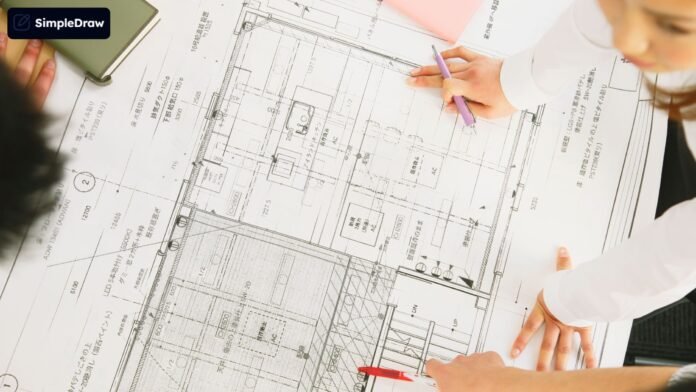SimpleDraw: The Founder Who Made CAD-Level Precision Free and Frictionless for DIY
The complexity of home renovation and DIY projects is often matched only by the complexity of the tools required to plan them. Professional-grade CAD (Computer-Aided Design) software is powerful, but it comes with prohibitive costs and a steep, soul-crushing learning curve. The average homeowner or budding entrepreneur is often forced back to the drawing board—literally—relying on the imprecise limitations of pen and paper.
This glaring gap between technical power and everyday accessibility is precisely what drove developer Diarmid Mackenzie to create SimpleDraw (SimpleDraw.app).
Based in Newton Abbot, Mackenzie’s innovation is not a new feature, but a radical simplification and democratization of utility. SimpleDraw is a powerful, web-based tool for creating precise, accurate DIY scale drawings and floor plans, offered completely free, with zero friction: no login or registration required. It is the first platform to successfully bridge the gap between the simplicity of a blank sheet of paper and the accuracy of professional design software, empowering millions of non-technical users to plan like a pro.
The Strategy of Subtraction: Why Simple is the New Powerful (H2)
For Diarmid Mackenzie, the challenge wasn’t just building a free floor plan creator; it was making sure that “free” didn’t mean “basic” and “powerful” didn’t mean “complicated.” The philosophy behind SimpleDraw is what he calls “Simplicity-First Precision.”
Most drawing software suffers from feature bloat, offering hundreds of tools that distract the user. SimpleDraw’s unique design philosophy focuses on a small, curated set of tools that are both simple to grasp and incredibly powerful in application.
“The goal was to be as easy to use as pen and paper, but with a great deal more flexibility and precision,” says Mackenzie.
This strategic subtraction resulted in key design choices that appeal directly to the DIY market:
- Dedicated Floor Plan Mode: This specialized mode is optimized for creating interiors, allowing users to draw walls, add windows, and insert doors with intuitive clicks—a clear nod to the most common use case.
- Smart Alignment System: This technical innovation is the engine of the app’s precision. It assists the user in placing points and lines exactly where they should be, with the alignment system adapting dynamically based on the zoom level, guaranteeing accuracy without the need for complex, manual coordinate inputs.
This strategic restraint in features allows SimpleDraw to deliver a high-quality experience without the intimidation factor of traditional easy CAD software.
The Frictionless Utility Advantage (H2)
In the startup world, SaaS growth strategies often obsess over the conversion funnel, but SimpleDraw’s model inverts this by focusing on frictionless utility. By removing the mandatory login and registration wall, Mackenzie is directly addressing the modern user’s fatigue with data collection and endless sign-ups.
This no login required software model achieves two critical outcomes:
- Instant Adoption: Users can access the tool and begin creating accurate designs immediately, capturing utility in the crucial moment of need (e.g., standing in a room with a tape measure).
- Viral Trust: Offering the core toolset for free, with no strings attached, builds organic trust and community engagement, leading to exponential word-of-mouth adoption among DIYers and hobbyists.
As the platform evolves towards its planned premium features (like PDF and DXF exports), this goodwill ensures a dedicated, willing base of paying users who are already deeply invested in the quality of the core product.
Actionable Lessons for Founders Democratizing Tools (H2)
The success of SimpleDraw offers profound lessons for founders in any vertical looking to disrupt a high-cost, high-complexity industry:
- Solve for the “Moment of Need”: SimpleDraw understood that the ideal user needs to start drawing now, not after navigating five signup pages. Look for ways to eliminate all friction in the initial user journey.
- Democratize Power, Not Features: Don’t try to replicate every feature of a legacy tool. Instead, identify the most powerful core function (e.g., precision scaling) and wrap it in the simplest possible interface.
- Community-Driven Precision: SimpleDraw’s roadmap is explicitly linked to user feedback via Discord, proving that the most effective way to refine a niche technical tool is through constant, direct communication with its dedicated user base. This ensures that new features (like interior fixtures) genuinely serve the need for home renovation planning tools.
- Monetize Utility, Not Access: By keeping the core drawing tools free, the platform establishes its value before asking for payment for advanced, professional-grade capabilities (like specialized export formats).
The Future of the Digital Blueprint (H2)
Diarmid Mackenzie and SimpleDraw are not just building a product; they are advocating for the democratization of design. In the coming years, the ability to create highly accurate blueprints will no longer be limited to architects or engineers. Platforms like SimpleDraw are empowering a new generation of DIY creators to plan, visualize, and execute their visions with confidence. It is a powerful reminder that sometimes, the most profound technical innovation is the one that removes the barriers to entry, making powerful technology accessible to absolutely everyone.
Are you a startup founder or innovator with a story to tell? We want to hear from you! Submit Your Startup to be featured on Taalk.com.








